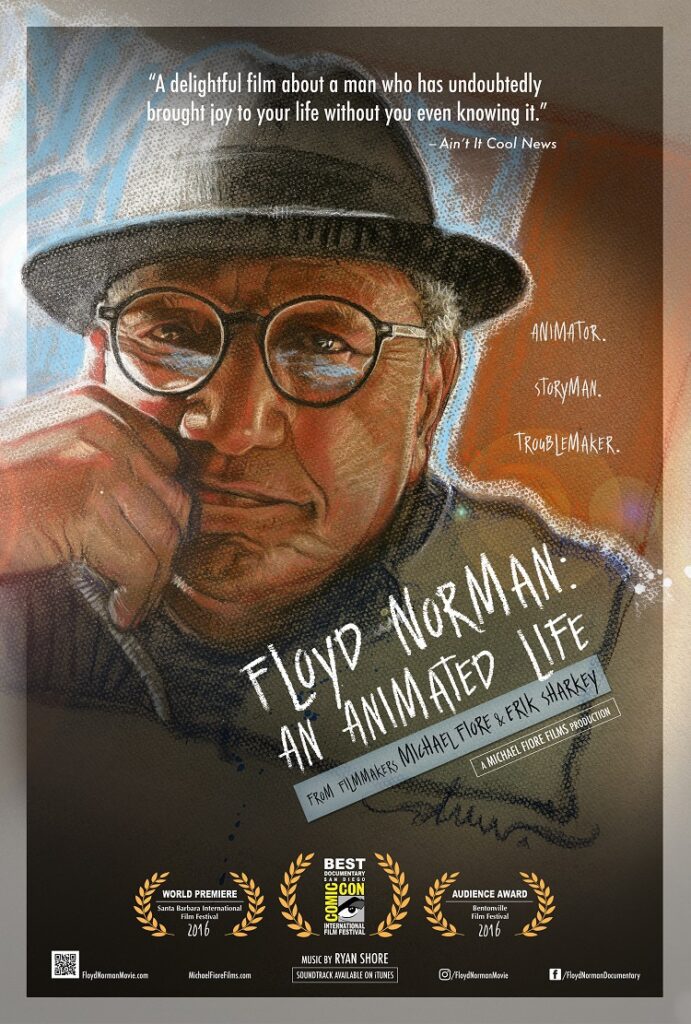
Written by Kristen Lopez
My knowledge of the Walt Disney Company meant I immediately recognized the name Floyd Norman. No matter what he says, Norman is considered a legendary animator, for both breaking the studio’s unspoken color barrier and for being one of the rare animators able to gain knowledge from Disney’s “Nine Old Men.” He now stands as one of the last animators to have worked with Walt Disney; the last living animator to work on The Jungle Book. With such a record of distinction it’s amazing to hear Norman’s just now receiving a documentary. Floyd Norman: An Animated Life charts Norman’s rise up the Disney ladder, his roles in other landmark cartoons, and how his forced retirement at 65 threatened to destroy him.
The uninitiated will only recall Norman’s name as the answer to a Jeopardy question: “Name the first black animator Walt Disney hired.” Norman himself will say that his race didn’t factor, either positively or negatively, in his hiring at Disney, a statement at odds with many of his friends and acquaintances. Walt Disney took his time hiring minorities, and directors Michael Fiore and Eric Sharkey do their best to look at Disney’s barriers during the 1940s-1960s while remaining respectful of Norman’s continued love with the place that gave him his first serious opportunity. We’ll neverk know the true extent of what it meant to be a black animator at Disney, whether Norman was mistreated at times by ignorance. Norman maintains it was his talent that secured him the job and that’s evident in the work he’s done, both for Disney and with other studios.
An Animated Life takes a leisurely approach to the animator’s life, following him during his day-to-day as he continues to visit the Walt Disney Studios. Where he once was an employee he’s now at the mercy of being a visitor. Norman’s endearing personality makes him a beacon for fans of Disney, a reputation he’s welcoming to, but not eager to flaunt. A birthday celebration he hopes to keep quiet soon turns into an influx of people asking for autographs, a necessary evil of being one of the last golden era animators.
It’s this legacy that you’d assume Disney would be eager to protect. Norman’s forced retirement is the saddest element in a life that’s been rather filled with happiness. Though Norman did work outside of Disney – spending time on nearly every major cartoon airing in the ’70s – it’s evident the animator needs work to remain young inside. Those aware of current Disney news will know where Norman’s career is currently at, lending the documentary a happy ending, of sorts.
The requisite talking heads describe Norman and his career, but An Animated Life works best when Fiore and Sharkey follow Norman around. They’ve found one of the most ebullient subjects out there that just him eating lunch with a bunch of other animators, reminiscing about the good old days, is worthy of a 90-minute documentary. Sharkey himself is best known as the documentarian behind the Drew Struzan film, Drew: The Man Behind the Poster, another tale of a man whose pen created legendary work. Norman’s animator’s lunch continues the trend of celebrating the animation style that’s, sadly, gone the way of the dodo.
Captured just as lovingly is Norman’s relationship with his second wife, Adrienne, a woman whom everyone credits as changing Norman’s life. Their love story, elegantly captured without being invasive, emphasizes Adrienne’s strong personality. It’s no wonder Norman’s first wife found herself jealous, realizing that Adrienne held the power to change Norman’s way of life, helping him to live more fully.
Whether you recognize Norman’s name or not, Floyd Norman: An Animated Life lives up to its name. Norman’s animated presence is infectiously enjoyable that you’ll smile with every stroke of his pen.